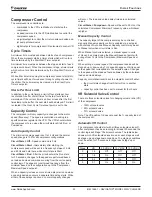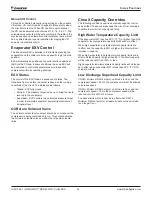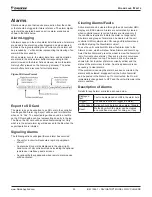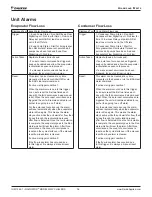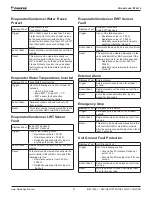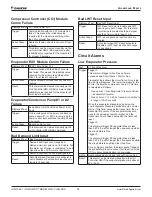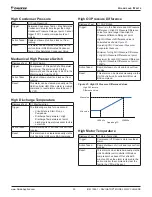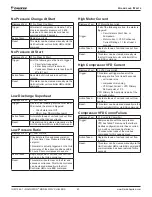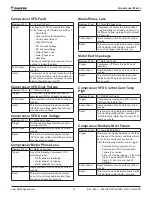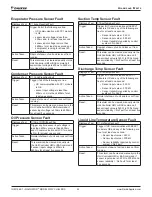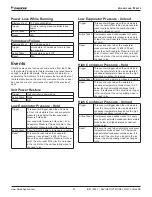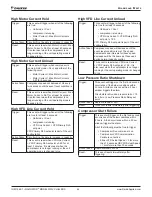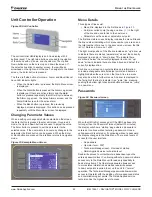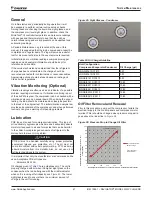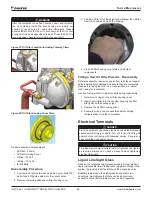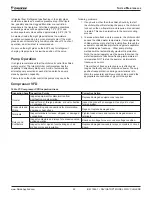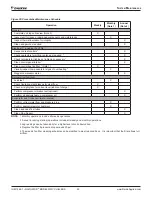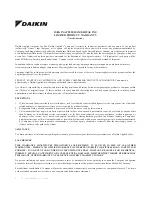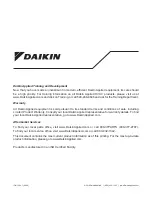
s
ysTem
m
aInTenanCe
www.DaikinApplied.com 47
IOM 1264-1 • NAVIGATOR
®
MODEL WWV CHILLERS
s
ysTem
m
aInTenanCe
General
On initial startup and periodically during operation, it will
be necessary to perform certain routine service checks.
Among these are checking the liquid line sight glasses, and
the compressor oil level sight glass. In addition, check the
MicroTech
®
III controller temperature and pressure readings
with gauges and thermometers to see that the unit has
normal condensing and suction pressure and superheat and
subcooling readings.
A Periodic Maintenance Log is located at the end of this
manual. It is suggested that the log be copied and a report be
completed on a regular basis. The log will serve as a useful
tool for a service technician in the event service is required.
Initial startup date, vibration readings, compressor megger
readings and oil analysis information should be kept for
reference base-line data.
If the service technician has determined that the refrigerant
charge has been contaminated, the charge should be
recovered and tested for contaminates or noncondensables.
Appropriate actions should be taken based on testing and
Clean Air Act regulations.
Vibration Monitoring (Optional)
Vibration readings are often used as an indicator of a possible
problem requiring maintenance. If vibration monitoring is part
of the site PM program, the compressor can be checked with a
vibration analyzer on an annual basis. When doing the annual
testing, the load should be maintained as closely as possible
to the load of the original test. The initial vibration analysis test
provides a benchmark of the compressor, and when performed
routinely, can give a warning of impending problems.
Lubrication
POE type oil is used for compressor lubrication. This type of
oil is extremely hygroscopic which means it will quickly absorb
moisture if exposed to air and form acids that can be harmful
to the chiller. Avoid prolonged exposure of refrigerant to the
atmosphere to prevent this problem.
CAUTION
POE oil must be handled carefully using proper protective
equipment (gloves, eye protection, etc.). The oil must not
come into contact with certain polymers (e.g. PVC) as it may
absorb moisture from this material. Also, do not use oil or
refrigerant additives to the system.
It is important that only the manufacturer’s recommended oil be
used. Acceptable POE oil types are:
• Emkarate RL 220H
Oil charges given in
Table 30
are guidelines only. The unit is
properly charged with oil when the higher sight glass on the
condenser has the red ball aligned with the middle indicator
when unit is running at full capacity, see
Figure 25.
The lower
sightglass is used to ensure there is a minimum amount of
charge in the unit for running.
Figure 25: Sight Glasses - Condenser
Table 30: Oil Charge Guideline
Unit Configuration
Compressor/Evaporator/Condenser Oil Charge (gal)
JNNS/E1610/C1810
9.20
JNNS/E1610/C2010
9.20
MNNS/E1610/C1810
9.20
MNNS/E1610/C2010
10.83
MNNS/E2010/C2010
10.83
MNNS/E2410/C2410
10.83
RNNS/E2010/C2010
10.83
RNNS/E2410/C2410
10.83
Oil Filter Removal and Renewal
Prior to this procedure, pump out the compressor. Isolate the
electrical supply to the control panels and compressor motor
terminal. Filter should be changed when pressure drop delta
goes above the linear line in
Figure 26.
Figure 26: Pressure Drop to Change Oil Filter
y = 0.3846x + 10.596
0
10
20
30
40
50
60
70
80
90
100
0
50
100
150
200
250
O
il
Pr
es
su
re D
iff
er
en
ce =
C
on
den
ser
P
res
su
re
-O
il
Pr
essu
re
(P
SI
G
)
Operating Pressure Difference = Condenser Pressure
-
Evaporator Pressure (PSIG)
Recommended Filter
Delta P Change
Linear (Oil Filter
Pressure Drop)
Содержание Navigator WWV
Страница 4: ......

